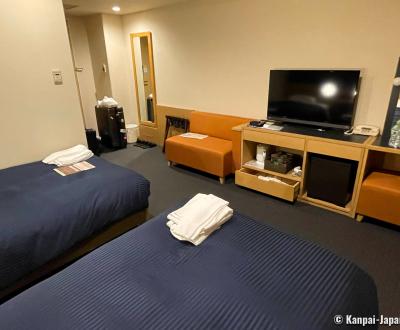Our Experience of the Enforced Hotel Quarantine Upon Arrival in Japan
Back from a year-end holiday in France, one member of Kanpai’s staff, who is a permanent resident in Japan, spent the required 6-days isolation in a hotel 🏨 upon landing in Japan. The quarantine period’s duration varies according to the countries and the overall health situation: when Covid 🦠 was less virulent (especially in summer) no self-isolation measure was required, but it is not the case in this 2021-2022 winter due to the spread of the Omicron variant.
We have reported below this unusual experience. Note that quarantine measures are not aimed at tourists, since the borders are still closed for this category of visitors, but in our case they were carried out for a long-term resident in Japan.
At the arrival airport
First thing first, contrary to what might think nationalists and Wapaneses: most passengers in the plane ✈️ to Japan were Japanese citizens, either returning from vacations or from an overseas work assignment. However, the same control procedure applies for everyone at the airport before the quarantine. We experienced borders control enforcement at Kansai International Airport in Osaka.
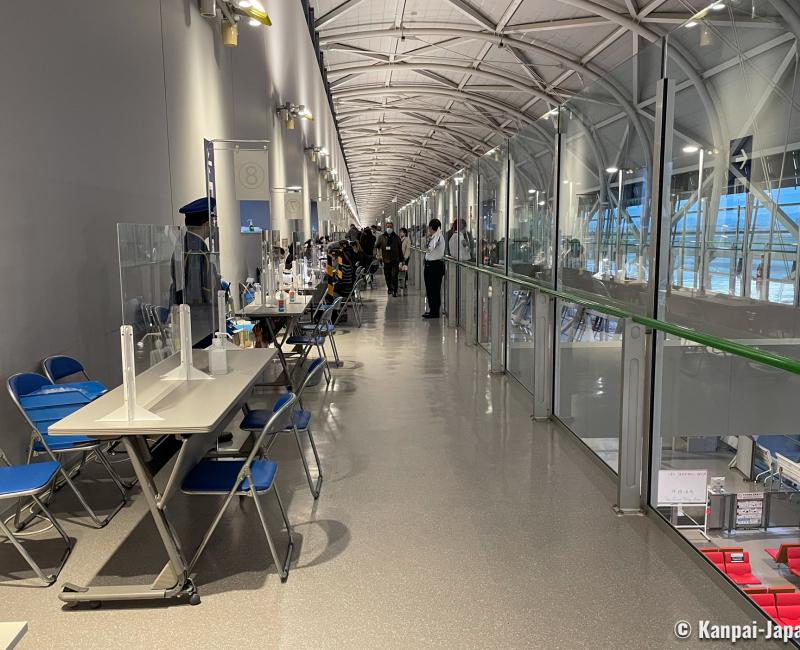
Travelers are now forbidden to take the Wing Shuttles and must therefore walk 1 to 2 kilometers with their hand luggage to reach the control area. On the way, all the lavatories were closed, and thus unusable: one must have planned a last trip to the loo before disembarking the plane. In the control area, staffs checked the paperwork filled in the plane: country of origin, transit country for stopover flights, seat number, etc. Newly arrived passengers must fill in a pledge document with ID information and possible symptoms: fever, difficulty breathing, tiredness, loss of taste or smell (even though the latter symptoms seem less likely with Omicron).
Each person received a number for confidentiality, and a badge with a strap either orange for a self-isolation in a hotel, or red for self-isolation at home. Everyone must take a saliva PCR test. Then, the time waiting for the results was not wasted thanks to Japan’s infamous love for paperwork, as we were handed what seemed mountains of forms to fill in. Those who had previously filled in the questionnaire on the MOFA (Japan’s Ministry of Foreign Affairs)’s website had their QR code scanned, otherwise they had to enter another waiting line. Meanwhile, our body temperature was automatically measured by a camera 📷. Travelers must indicate their possible allergies and food preferences for the catering that would be provided by the hotel.
After a while, people were introduced in another boarding area where tables were laid out for smartphone 📱 configuration. The use of a smartphone is mandatory: if you don’t have one or if it is too old, you will be required to rent one on the spot. The staff installed the MySOS app (that existed before the pandemic for a medical use), set it to the "Covid quarantine" mode and handed us a 32-page (!) user guide only in Japanese. It is however possible to switch the language app to English. Your e-mail address is checked by sending a test message, then your GPS is set to activate localization.
The PCR test result was announced after a 1 to 2 hours wait. Travelers were called by the number they were given at the beginning of the process. If the test result was positive, they were picked up by a person clad in coveralls and visor above the sanitary mask 😷. If negative, you were allowed to the immigration, where all the documents were checked again by the staff, especially the passport and the MOFA’s Japanese form corresponding to the mandatory PCR test made 72h prior to embarkation (the laboratory’s results are not accepted, even in English). Then, it is finally time to pick up our luggage, that are orderly waiting since the landing. Overall, it took a little bit more than 2h30 of administrative work, checking and waiting before being allowed to go out of the airport.
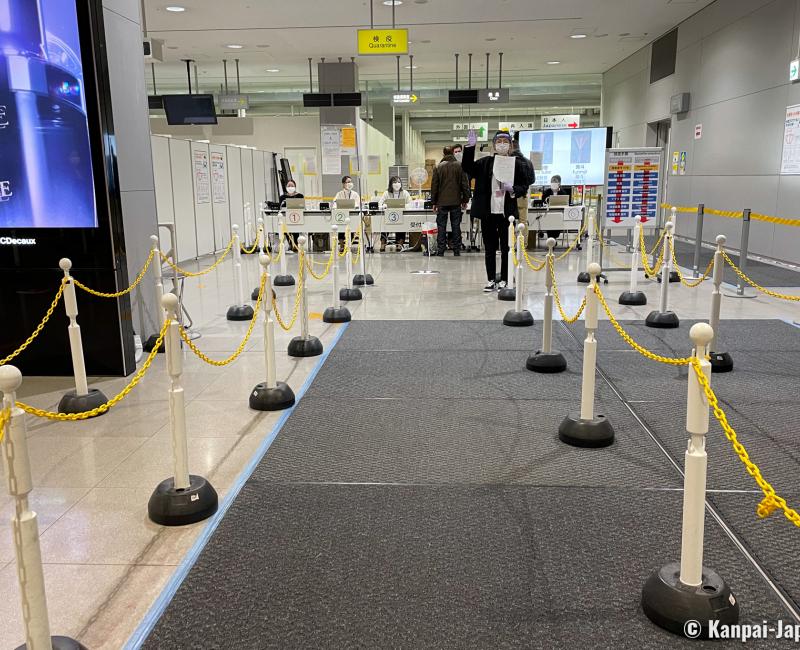
After clearing the customs 🛂 procedures, guards wearing jackets with "quarantine" written on their backs guided the passengers to the entrance and the bus to the hotel. We asked to go to the toilets 🚽 before boarding and were accompanied by a guard who waited in front of the door. In the bus, passengers were placed to maintain social distance, and the upper part of each seat was fitted with plexiglass sheets. Then, on to a 6-days isolation at the hotel!
6 days of self-isolation in a hotel room...
Naturally, the quarantine hotel was never announced beforehand. As for us, we were sent to the Kansai Airport Washington, on the other side of the bridge that connects the airport to Honshu, at only a 10 minutes’ bus ride. The attribution of the hotel is not related to the passenger’s status (we are not journalists), neither to the flight’s class (something even Novak Djokovic realized in Australia).
Rules and procedures
We were allowed in the hotel not from the front door but from the backdoor, and always surrounded by guards.
We had to take the elevator to our (non-mixed) floor one by one and were welcomed by 5 other persons waiting for us to check our ID, our food preferences, and symptoms if any. Then, we were explained the procedures that would shape the next 6 days: schedules and catering, availability of the reception (from 7 a.m. to 9 p.m. in our case), how to take out the trash, change bed sheets and towels, etc. The room will indeed not be visited by any hotel staff during the whole quarantine. A chair is placed in front of the door as a link with the outside world: it will be used to place the meals, take out trash, etc. On a side note, throwing bottles was forbidden, which led to quite an accumulation at the end of the isolation period.
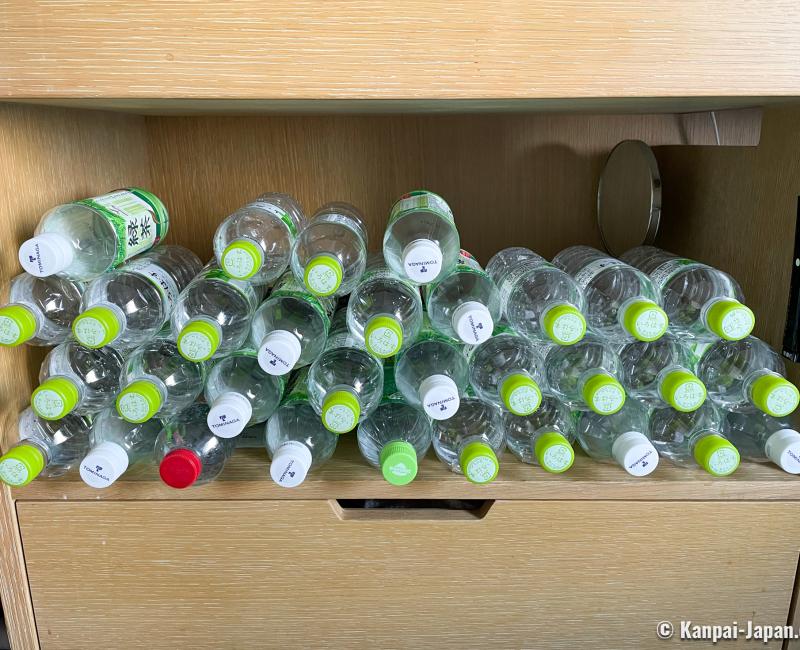
Except for raw food (such as sushi 🍣) in fear of food poisoning, it was possible to have food delivered via Uber Eats. But in fact, it was not so simple: very few delivery services were available in the airport area where we stayed. And when trying via other delivery apps, it was not always possible to pay with a bank or credit card 💳 and the hotel did not pay in cash at the reception on behalf of their customers.
There was no problem however with more classical parcels provided the reception was informed of the delivery time beforehand. Moreover, the hotel provided 3 50cl bottles per day, as well as tea and coffee without limit. It was also possible to have a spare pillow or blanket, if necessary, as well as sanitary pads for women. The hotel generally provided the requested items within 10 to 15 minutes.
An important notice for tobacco lovers: smoking is prohibited in the room! While we were not personally affected, we noticed that the hotel provided free nicotine gums. Isn’t it a good occasion to quit smoking? In the same manner, alcohol consumption was also forbidden, as it may impair the Covid self-test results (see below).
Lastly, each of us received a form to fill in body temperature on the morning and evening, with an old thermometer for axillary measurement, that takes 3 minutes to do its job! If the temperature was above 37,5°C or if any symptom arose, the reception must be called immediately. Note that we did not have problem as we speak Japanese, but the hotel staff was not fluent in English, which could lead to some misunderstanding.
Room and daily routine
We checked the hotel’s location in the GPS app to indicate where we would stay on those first 6 days.
We were lucky: our hotel was new and the room very clean, quite large with about a 20m² superficies in total. We had 2 semi-double beds with good bedding, a small sofa and footstool, toilets, and bathtub in the room and even some space to move around. Sound isolation was good, and everybody was not blessed with such nice amenities. In addition, the room was furnished with a TV (the only non-Japanese channel being CNN), a kettle and a small fridge as well as all the usual bathroom 🛁 amenities, but no microwave oven. The small window (facing the freeway) could only be slightly opened, and it was hard to ventilate the room. Moreover, the Wi-Fi connection was rather slow, but we had to do with it.
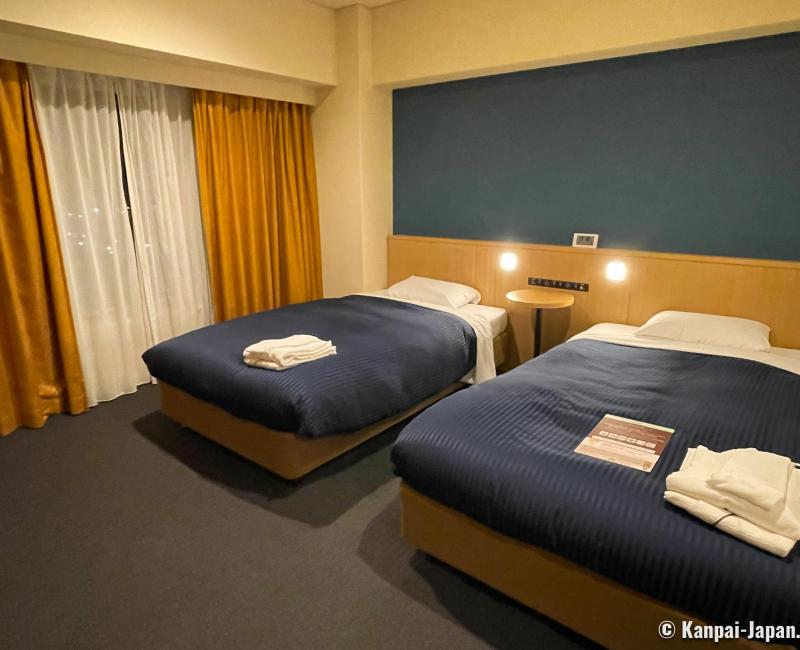
Every day, a robot called on MySOS at a random hour (not during the night obviously) a few minutes after sending a notification. The smartphone automatically sets on the "selfie" mode to control at once our face (without sanitary mask) and our surroundings in the quarantine place. It is not a very big deal to miss a call once, but we were clearly explained that it should not happen on a regular basis… Moreover, we had to fill in every day our health condition, by checking for symptoms such as fever and / or Covid symptoms. Lastly, the GPS location must be validated several times a day.
The evening before the 3rd and 6th days, an autonomous saliva test kit was delivered and had to be returned before 7 a.m. the next morning. The results came in in the early afternoon. If both tests were negative, we were allowed to leave the hotel on the 6th day.
Contents of the meals
The 3 meals of the day were delivered on the chair respectively at 8 a.m., 12:30 p.m. and 6 p.m. (if not retrieved immediately we got a call from the reception). Fortunately, we did not have loudspeakers announcements: some friends told us they were woken up daily at 6:30 a.m.! The contents of the meals were almost identical each day with a 3-day turnover, precisely:
- Breakfast: konbini sandwich, salad, fruit, yogurt, and juice brick.
- Lunch (Keishoku - light- type): small portion of rice with toppings or curry rice or ankake rice (vegetables and seafood) or pasta, salad with "italia" or "tomato" sauce, and for desert mochi or warabi-mochi or fruit salad and a bottle of green tea.
- Dinner: a pack of rice with a bento 🍱 salad and side dishes (tonkatsu, salmon, sweet potato, tofu…), small roll-cake for desert or fruit salad and a bottle of green tea.
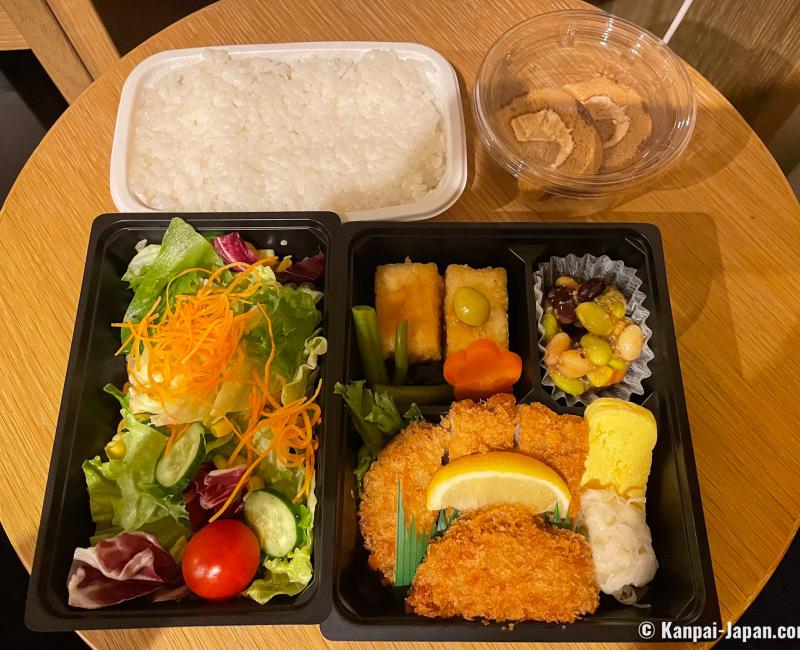
The portion for lunch was even smaller than in the plane and depending on your eating habits it can be very (too) light. Fortunately, heading back from France we had packed some sliced Poilâne bread and some cheese for this situation!
Our feedback
From a personal point of view, we did feel that the atmosphere was somehow strange. We were just allowed to briefly open the room’s door, wearing a face mask (FFP2-type was not required), to retrieve or take out items. Naturally, we did feel bored and like going around in circles, and above all to be deprived of our fundamental freedom. The fact that we were not allowed to go outside somehow reminded how a prison would be, even though the hotel’s comfort does not really allow the comparison.
However, a sword of Damocles was still hanging above our head: if the test returned positive on the 3rd or 6th day, or if another passenger of the same flight declared positive to the Omicron variant during the isolation (and if contact case depending on the seating in the plane), the quarantine period would be extended to 14 days, and one must change hotel for the 8 to 11 remaining days.
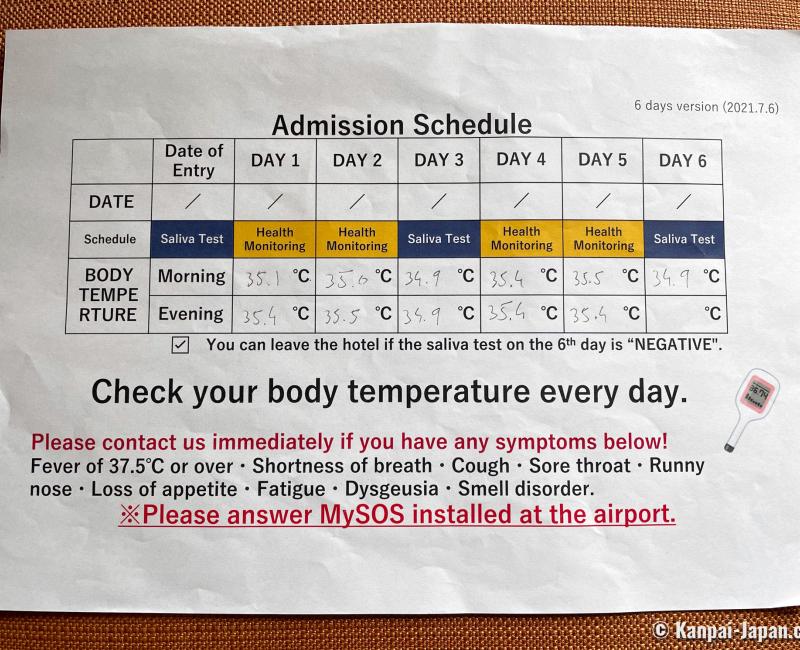
To be fair, this isolation period in a hotel was accomplished with the benefits of the Japanese-style service and was completely free for the traveler, as all charges were paid by the Japanese taxpayers (including permanent residents). It is not necessarily the case in many other countries such as Canada for example.
... Then 8 days at home
After 6 days, we were allowed to have someone pick us up at the hotel. However, many other facilities bring back travelers at the airport, regardless of where they usually live! Once there, the only ways to leave is to take a special (and expensive!) "corona" taxi, rent a car 🚙 or have someone pick you up.
We had to inform of the precise time to which our relative was arriving so as going out at the exact time, accompanied by two hotel staff who would not touch your belongings nor the room's door that must stay wide open. Then, we took the elevator alone and were handed a self-test to do at home on the 10th day. The car must stop at the indicated place as it was forbidden to walk around without the supervision of the hotel staff.
At home, we checked our location in the GPS again to indicate where we will be staying in the next 8 days. There would be every day, at a random hour, automatic control calls. We were only allowed to go out for the essentials and necessities: at the konbini or the neighborhood supermarket, or to buy a meal in a nearby restaurant with the "click & collect" system.
We will finally released from self-isolation, just in time for the Omicron pre-emergency measures?

